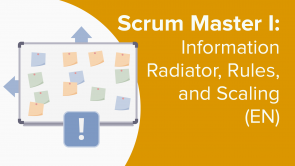Scrum Master I: Sample Exam

Über den Vortrag
Der Vortrag „Scrum Master I: Sample Exam“ von Dion Training ist Bestandteil des Kurses „Scrum Master I: Information Radiator, Rules, and Scaling (EN)“.
Quiz zum Vortrag
In total, there are four events that are part of the overall sprint in Scrum. Three of these are sprint planning, daily Scrum, and sprint retrospective. Which of the following BEST represents the fourth event? (Copyright © AXELOS Limited 2021, usage approved by AXELOS Limited. All rights reserved.)
- Sprint review
- Release planning
- Backlog refinement
- Sprint execution
Which of the following BEST explains a technique for sizing product backlog items in Scrum? (Copyright © AXELOS Limited 2021, usage approved by AXELOS Limited. All rights reserved.)
- The Developers identify two well-known stories against which other stories can be compared.
- The Scrum Master assigns a set of known stories for the Developers to compare against.
- The Product Owner identifies similar stories from a previous sprint to be used as baselines.
- The most experienced Scrum Developer will select certain previous stories as baselines.
Consider the following accountability: Ensuring that the product backlog is transparent, visible, and understood is part of effective product backlog management. This accountability BEST lies with which Scrum team member? (Copyright © AXELOS Limited 2021, usage approved by AXELOS Limited. All rights reserved.)
- Product Owner
- Product manager
- The Developers
- Scrum Master
Which TWO of the following BEST represent benefits of the sprint review event in Scrum? 1. Risks and issues can be identified 2. The sizing of user stories is more accurate 3. Feedback for adaptation is gathered 4. The Developers learn from one another (Copyright © AXELOS Limited 2021, usage approved by AXELOS Limited. All rights reserved.)
- 1,3
- 2,4
- 1,2
- 3,4
Which of the following BEST identifies what comprises the release backlog? (Copyright © AXELOS Limited 2021, usage approved by AXELOS Limited. All rights reserved.)
- Product backlog items completed in a sprint and accepted by customers
- Items that are identified as most important to customer satisfaction
- Sprint backlog items that are proven to fully meet the definition of done
- Items that meet all quality criteria and have successfully passed testing
Which TWO of the following BEST describe what happens during a sprint retrospective? 1. The team inspects the effectiveness of its interactions and processes. 2. Increment adaptations are identified and documented. 3. Velocity is calculated to determine if it can be increased. 4. Assumptions that caused customer dissatisfaction are discussed. (Copyright © AXELOS Limited 2021, usage approved by AXELOS Limited. All rights reserved.)
- 1,4
- 1,2
- 2,3
- 3,4
Which of the following BEST identifies inputs to the sprint retrospective event? (Copyright © AXELOS Limited 2021, usage approved by AXELOS Limited. All rights reserved.)
- Problems encountered during the sprint execution
- Customer dissatisfaction with the increment
- Velocity deviations over the last four sprints
- Adaptations requested by customers in the sprint review
Identify the missing words in the following sentence: The Developers decide the structure for the daily Scrum as long as _______________ for the day's work is produced. (Copyright © AXELOS Limited 2021, usage approved by AXELOS Limited. All rights reserved.)
- An actionable plan
- An amended goal
- A task list
- A burn-down chart
Which of the following is NOT part of the sprint backlog? (Copyright © AXELOS Limited 2021, usage approved by AXELOS Limited. All rights reserved.)
- Burn-down and burn-up charts
- A sprint goal as a commitment
- Selected product backlog items
- Actionable plan for the increment
Empiricism and Lean thinking form the basis of: (Copyright © AXELOS Limited 2021, usage approved by AXELOS Limited. All rights reserved.)
- Scrum theory
- Scrum artifacts
- Scrum knowledge
- Scrum events
Which of the following statements BEST describes how the Scrum Master serves the Product Owner? (Copyright © AXELOS Limited 2021, usage approved by AXELOS Limited. All rights reserved.)
- By facilitating stakeholder collaboration as needed
- By helping the employees understand and enact Scrum
- By ensuring all Scrum events take place and are productive
- By maintaining a focus on creating high-value increments
Which of the following statements about the definition of done is TRUE? (Copyright © AXELOS Limited 2021, usage approved by AXELOS Limited. All rights reserved.)
- Represents the commitment for all increments resulting from sprints
- Ensures all the user stories can be completed correctly during a sprint
- Identifies the criteria for a user story to be chosen in sprint planning
- Describes the efforts required to complete a user story during the sprint
Which of the following descriptions BEST explains the concept of an increment? (Copyright © AXELOS Limited 2021, usage approved by AXELOS Limited. All rights reserved.)
- All increments created during a sprint must work together for the sum of all of them to be presented during a sprint review.
- Each increment produced during a sprint must meet the team's definition of done and be independently verified to work.
- All work carried out by the Developers during the sprint will be included in the increment presented to customers.
- Every increment created by the Scrum team during the sprint execution is deemed usable and ready for release.
Which of the following statements BEST matches the characteristics of the sprint backlog? (Copyright © AXELOS Limited 2021, usage approved by AXELOS Limited. All rights reserved.)
- It is a plan for the Developers that is updated throughout the sprint.
- It represents the Product Owner's desires for what needs to be done.
- It is modified throughout the sprint and contains epics and features.
- It is used during the sprint to visually represent the completed work.
Which of the following BEST describes an accountability for the Developers on a Scrum team? (Copyright © AXELOS Limited 2021, usage approved by AXELOS Limited. All rights reserved.)
- Holding each other accountable as professionals
- Clearly documenting product backlog epics and stories
- Ensuring the highest levels of effectiveness and quality
- Maximizing the product value for the customers
Which of the following BEST describes the Scrum board and its use? (Copyright © AXELOS Limited 2021, usage approved by AXELOS Limited. All rights reserved.)
- A visual representation of task planning and flow management
- A visual means of controlling the number of product backlog items selected
- A visual way to display the time allocation for each sprint backlog item
- A visual display for the Product Owner to assign sprint tasks and user stories
Which of the following would NOT be a good fit for a self-managed team? (Copyright © AXELOS Limited 2021, usage approved by AXELOS Limited. All rights reserved.)
- Individuals who are not trusted by others
- Individuals who are respected by peers
- Individuals who exhibit good teamwork
- Individuals who are proven leaders
Which of the following BEST describes Scrum? (Copyright © AXELOS Limited 2021, usage approved by AXELOS Limited. All rights reserved.)
- A framework for generating value through adaptive solutions to complex problems
- The adaptive process used to manage all the complex products and solutions
- A predictive technique used to manage complex products and solutions
- The definitive method used to predictively manage complex products
Which TWO of the following statements BEST define the term “incremental”? 1. Each successive version of the product is usable. 2. Moving the project forward in a gradual manner. 3. Completing only the most critical user stories. 4. Each version builds upon the previous version. (Copyright © AXELOS Limited 2021, usage approved by AXELOS Limited. All rights reserved.)
- 1,4
- 2,3
- 1,3
- 2,4
Which of the following BEST defines the term product goal in Scrum? (Copyright © AXELOS Limited 2021, usage approved by AXELOS Limited. All rights reserved.)
- Describes a future state and serves as a target against which a Scrum team can plan
- Defines a vision for the Developers in terms of finding adaptive solutions
- Serves to drive all stakeholders toward making effective decisions during a sprint review
- Identifies the correct epics and features to be added to the backlog by the Product Owner
Discussions centering on the Developers' availability and velocity, the organization's definition of done, and the refined product backlog items occur during: (Copyright © AXELOS Limited 2021, usage approved by AXELOS Limited. All rights reserved.)
- Planning for the upcoming sprint
- Executing the daily work
- Prioritizing the product backlog
- Forecasting the completion date
Which of the following is NOT an input to sprint execution? (Copyright © AXELOS Limited 2021, usage approved by AXELOS Limited. All rights reserved.)
- The refined product backlog
- The sprint goal
- The definition of done
- The sprint backlog
Which of the following BEST defines a "feature" in relation to product backlog items? (Copyright © AXELOS Limited 2021, usage approved by AXELOS Limited. All rights reserved.)
- A group of related user stories used for complex products
- A refined and ready-for-development requirement
- An entire workflow that is large and broadly defined
- A discrete part of the overall product’s functionality
Which of the following BEST identifies an output from the sprint execution? (Copyright © AXELOS Limited 2021, usage approved by AXELOS Limited. All rights reserved.)
- One or more increments
- New product backlog items
- Resolutions to problems
- Refined product backlog
Which of the following BEST describes product backlog refinement? (Copyright © AXELOS Limited 2021, usage approved by AXELOS Limited. All rights reserved.)
- An ongoing process of adding sizes, more detail, and an order to backlog items
- A time-boxed event during which sizes are added to backlog items chosen for the sprint
- An iterative adjustment of the product backlog by the Product Owner and customers
- A repetitive activity during which customers add more detail to the epics and user stories
During which Scrum event will attendees collaborate with the Scrum team to determine the next steps and if any adjustments are needed to the product backlog? (Copyright © AXELOS Limited 2021, usage approved by AXELOS Limited. All rights reserved.)
- Sprint review
- Sprint retrospective
- Sprint execution
- Sprint planning
Which of the following BEST identifies the three types of acceptance criteria for product backlog items? (Copyright © AXELOS Limited 2021, usage approved by AXELOS Limited. All rights reserved.)
- Non-functional, functional, and performance
- Effectiveness, quality, and performance
- Functional, non-functional, and quality
- Performance, functional, and quality
Which of the following BEST describes an output of the sprint review event in Scrum? (Copyright © AXELOS Limited 2021, usage approved by AXELOS Limited. All rights reserved.)
- The refined product backlog
- The updated sprint backlog
- The new sprint goal
- The new product goal
A sizing technique that uses a relative unit of measure for expressing the size of the overall effort that will be required to fully implement a product backlog item is BEST known as: (Copyright © AXELOS Limited 2021, usage approved by AXELOS Limited. All rights reserved.)
- Story point sizing
- Ideal time sizing
- Absolute sizing
- Fibonacci sizing
Which of the following does NOT describe the purpose of the events in Scrum? (Copyright © AXELOS Limited 2021, usage approved by AXELOS Limited. All rights reserved.)
- Embracing the Scrum values
- Making artifacts transparent
- Inspection of the artifacts
- Adaptation as required
The Developers have requested a meeting with the Product Owner because a customer has asked for some changes to several sprint backlog items. Which of the following describes the BEST appropriate response from the Product Owner? (Copyright © AXELOS Limited 2021, usage approved by AXELOS Limited. All rights reserved.)
- The Product Owner agrees to the changes since it is clear they will not alter the sprint goal.
- The Product Owner denies the changes since the Developers have already begun working.
- The Product Owner allows the changes even though some do not align with the sprint goal.
- The Product Owner rejects all changes because of time constraints in the sprint duration.
Which TWO of the following BEST represent benefits of Agile project management? 1. Increased levels of productivity 2. Guaranteed delivery dates 3. The prevention of expanded scope 4. Higher stakeholder satisfaction (Copyright © AXELOS Limited 2021, usage approved by AXELOS Limited. All rights reserved.)
- 1,4
- 1,2
- 2,3
- 3,4
In total, there are four values outlined in the Agile Manifesto with three identified here: Working software over comprehensive documentation, individuals and interactions over processes and tools, and responding to change over following a plan. Identify the fourth value. (Copyright © AXELOS Limited 2021, usage approved by AXELOS Limited. All rights reserved.)
- Customer collaboration over contract negotiation
- Team members' collaboration over timelines
- Transparency and inspection over documentation
- Working software over inspection and adaptation
During the sprint review event, who will present the increment(s) that BEST represent the results of the work performed during sprint execution? (Copyright © AXELOS Limited 2021, usage approved by AXELOS Limited. All rights reserved.)
- Scrum team
- The Developers
- Scrum Master
- Product Owner
Which TWO of the following statements below BEST describe the key factors in the success of Agile project management? 1. Developer versatility with automated testing 2. Ensuring there is a clear product vision 3. Completing the product on time and on budget 4. Developing the roadmap as the project progresses (Copyright © AXELOS Limited 2021, usage approved by AXELOS Limited. All rights reserved.)
- 1,2
- 1,3
- 3,4
- 2,4
Which of the following statements does NOT apply to the concept of velocity? (Copyright © AXELOS Limited 2021, usage approved by AXELOS Limited. All rights reserved.)
- Used to compare one Scrum team to another
- Total story points completed per sprint
- Not a goal, but is used for forecasting
- Should be steady or increasing over time
Which TWO of the following statements BEST identify benefits of the daily Scrum? 1. Determines solution to impediments 2. Enables quick decision-making 3. Updates the Product Owner daily 4. Optimizes Developers' collaboration (Copyright © AXELOS Limited 2021, usage approved by AXELOS Limited. All rights reserved.)
- 2,4
- 1,2
- 2,3
- 1,3
Which of the following suggestions when writing good user stories is TRUE? (Copyright © AXELOS Limited 2021, usage approved by AXELOS Limited. All rights reserved.)
- Start with epics and refine until ready for selection.
- Write the most complex stories first, then prioritize.
- Start with the smallest stories first, then group into features.
- Create independently and then sort them to compare.
Which Scrum value is BEST being demonstrated by the members of the Scrum team as they share with each other any challenges being encountered? (Copyright © AXELOS Limited 2021, usage approved by AXELOS Limited. All rights reserved.)
- Openness
- Focus
- Transparency
- Commitment
Which of the following BEST represents an ordered list of customer requirements that will continue to evolve over time based on the changing needs of the customer? (Copyright © AXELOS Limited 2021, usage approved by AXELOS Limited. All rights reserved.)
- Product backlog
- Epic backlog
- Sprint backlog
- Story backlog
Kundenrezensionen
5,0 von 5 Sternen
| 5 Sterne |
|
5 |
| 4 Sterne |
|
0 |
| 3 Sterne |
|
0 |
| 2 Sterne |
|
0 |
| 1 Stern |
|
0 |




